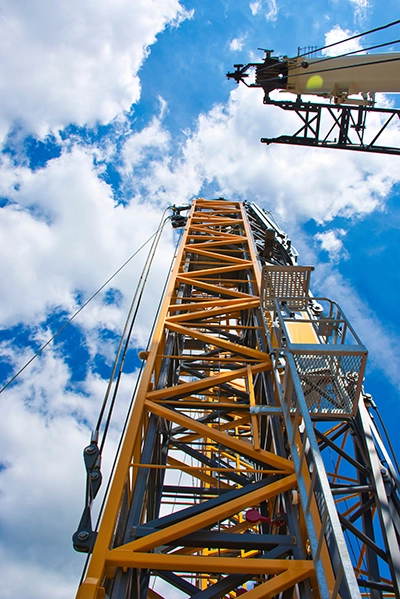Bedrock Evaluation
With over thirty years of experience, Pace® offers advanced, comprehensive bedrock and waste rock assessments and testing. We promise to deliver a level of quality that meets your data objectives, supported by personal service, ethical standards, data transparency, and the highest level of support possible.
Discover Our Capabilities

What Is Hydraulic Fracturing (Fracking)?
Hydraulic fracturing, commonly known as fracking, is the process of injecting water, sand, and/or chemicals into a well to break up underground bedrock and release trapped oil or gas reserves. Fracking has been used commercially for more than 65 years to reach previously untapped sources of fossil fuels. Today, advanced hydraulic fracturing and horizontal drilling techniques are responsible for most of the surge in U.S. oil and natural gas production.
Since fracking involves injecting a chemical solution into the ground to free up oil and gas resources, there are some potential environmental impacts related to this process. These include:
- Spills of chemicals at the surface
- Surface-water-quality degradation from waste fluid disposal
- Groundwater quality contamination
- Induced seismicity from the injection of waste fluids into deep disposal wells.
How Is Fracking Regulated?
The United States Geological Survey (USGS) monitors the environmental impact fracking across the country, from potential earthquakes to degraded groundwater quality. While states have a lot of oversight of fracking at the local level, this drilling technique is also covered by a number of federal environmental programs.
The United State Environmental Protection Agency (EPA) has the authority to limit emissions of some pollutants, and the agency issued new rules in 2012 to limit emissions of air pollutants from fracking.
The CWA requires the EPA to develop water quality criteria for surface waters that accurately reflect the latest scientific knowledge on the impacts of pollutants on human health and the environment. Petroleum industry waste, including frac flowback and produced water, cannot be discharged to the waters of the United States, except under an NPDES or equivalent state permit.
RCRA gives the EPA the authority to control hazardous waste from the "cradle-to-grave and also provides a framework for the management of non-hazardous solid wastes. In 1980, the Solid Waste Disposal Act Amendments exempted drilling fluids, produced water, and other wastes associated with the exploration, development, or production of oil or gas wells from being regulated as hazardous waste regardless of whether the waste exhibits hazardous characteristics.
Other wastes, such as unused fracturing fluids or acids, waste solvents, painting wastes, and oil and gas service wastes, generated from activities other than the well or field operations may be regulated as hazardous. RCRA also authorizes the EPA to issue orders in cases where handling, treatment, or storage of hazardous or solid waste may present an imminent and substantial endangerment to health or to the environment.
CERCLA gives the EPA broad authority to respond directly to releases or threatened releases of hazardous substances into the environment. CERCLA requires operators of oil and gas sites to report releases of hazardous substances above reportable quantities to the National Response Center. However, under Section 9601(14) of CERCLA, releases of petroleum and petroleum products are excluded. The liability and reporting provisions also do not apply to injections of fluids authorized by state law for production, enhanced recovery, or produced water.
Oil and gas well operators would be required to report any releases to the environment of hazardous substances, other than petroleum, such as PCBs or pesticides, which are sometimes mixed with petroleum product.
Despite the petroleum exemption, the EPA has exercised its power under CERCLA to intervene where it considers oil and gas operations to pose "imminent and substantial danger to the public health or welfare." Citing its CERCLA authority, the EPA has investigated instances of groundwater pollution it believed were related to oil and gas wells.
TSCA provides the EPA with the authority to require reporting, record-keeping and testing requirements, and restrictions relating to chemical substances and/or mixtures. The EPA maintains a list of chemicals known as the TSCA inventory that are or have been manufactured or processed in the United States. Many of the chemicals used in hydraulic fracturing are on the list.


Hydraulic Fracking Services
To ensure safe processes, protect the environment, and comply with emerging state regulations, Pace® provides analytical services from pre-drilling to post-drilling activities, including:
- Surface Spills/Accident-Related Services
- Flowback Water/Wastewater Disposal Issues
- Pit Closure Analysis Support/Drill Pad Reclamation
- Pre- and Post-Drill Baseline Testing
- Naturally Occurring Radioactive Material (NORM)
- Emissions Associated with Compressors
- Ground Water Compliance Monitoring
Key Shale And Gas Markets
- Marcellus Shale
- Utica Shale
- Eagle Ford Shale
- Woodford Shale
- Bakken Shale
- Barnett Shale
- Fayetteville Shale


What Is Mining Waste Characterization?
Mining waste characterization is the study of the environmental impacts of mining materials and waste produced during the mining, processing, and above-ground storage of ore prior to treatment. The primary impacts associated with waste rock depend on its geochemistry and site conditions. Waste rock can be a source of contaminated, reactive materials, such as acid rock drainage, and heavy metals (e.g., arsenic.) All of these can adversely impact aquatic and other organisms, as well as surface and ground waters.
Waste characterization needs to consider whether the waste will cause:
- PAG (potentially acid generating materials)
- Saline and/or sodic drainage (i.e., neutral mine drainage)
- Leaching and mobilization of metals and contaminated compounds
- Agronomic
Types Of Mining Materials And Mining Waste
Derived from the extraction and processing of mineral resources, mining materials can contain large quantities of potential harmful natural materials, such as heavy metals. Extracting and processing metals and metal compounds can also result in acid mine drainage.
OVERBURDEN
In mining, overburden refers to the layer of soil and/or rock that lies above the valuable material being mined.
WASTE ROCK
Waste rock consists of excavated low-grade bedrock that has been transported away to access profitable ore. Waste rock is typically composed of relatively coarse, granular broken rock in the size range of sands to boulders and do not have metal concentrations of economic interest.
TAILINGS
Tailings are the materials left over after the process of separating the valuable fraction from the uneconomic fraction of an ore. Depending on how the extraction of mineral occurs Tailings can be dangerous sources of chemicals such as heavy metals, sulfides, and radioactive content.
Mining Waste Regulations
To minimize the environmental impact of mining, sites are required to abide by legislative environmental quality standards throughout the entire mining cycle, i.e., exploration, planning, development, and mine closure.
The CAA authorizes regulations to address airborne pollution that could potentially harm human health or natural resources. Mining-related situations that fall under these regulations include dust emissions that are associated with operations or tailings disposal in impoundments, exhaust emissions from heavy equipment, and emissions from processing facilities, such as smelters.
The Clean Water Act authorizes the creation of rules that govern the release of harmful substances into surface water. Its ultimate aim is to ensure that all surface waters are safe and free from any hazardous discharges. One of the key mechanisms established under the ClWA is a permitting framework for the discharge of pollutants, known as the National Pollutant Discharge Elimination System (NPDES). Regulations under the Clean Water Act cover various mining-related activities, including the disposal of mining-related fluids, pumping or draining of mine water to the surface, storm water runoff in mining areas, and management of seepages from mine tailings impoundments.
RCRA gives the EPA the authority to control hazardous waste from the "cradle-to-grave.” Most extraction and beneficiation waste from hardrock mining (the mining of metallic ores and phosphate rock) and 20 specific mineral processing wastes have been excluded from federal hazardous waste regulations under Subtitle C of RCRA. The remainder of mineral processing wastes are regulated under RCRA and subject to applicable rules.
The TSCA focuses on controlling the development and application of new and existing chemical substances. Chemicals and hazardous materials used in the processing of ore or ore concentrates, such as sodium cyanide solutions used in the leaching of gold ores, are regulated under TSCA.
CERCLA authorizes the EPA to order the clean up any site where there is an unremedied release of a hazardous substance. Hazardous substances are broadly defined under CERCLA and encompass mining, milling, and smelter wastes that are currently not regulated by RCRA. Regulators can access special funds, take emergency measures, and hold all previous owners or contributors accountable for cleaning up the site.
In the United States, the main federal law governing the environmental impact of coal mining is known as SMCRA. This law established two programs: one for regulating operational coal mines and another for rehabilitating abandoned mine lands. The regulatory standards outlined in SMCRA are primarily aimed at ensuring the stability of waste piles and reservoirs. Although there are no specific provisions for identifying hazardous mining wastes in SMCRA, other potentially harmful non-coal materials connected to mining activities are subject to regulation under this law.

Mine Waste Analytical Services
Environmental challenges exist throughout the life of a mine, from exploration to closure. Pace® offers methods that determine the acid-producing potential of mine tailings, overburden, and mine waste rock. Analyses to provide acid-base accounting and predict acid mine drainage include kinetic testing with simulated weathering columns and cells.
Our mining support services provide a complete range of laboratory analysis to meet the environmental requirements of the mining industry in accordance with recognized standards. These mining support services are available to assist our clients in their predictions for proposed mines and assessment at operating mines and monitoring for closure activities.
- Acid Base Accounting
- Humidity Cells
- SPLP Testing
- Overburden Analysis
- Agronomic Analysis
- Topsoil Analysis
- Total and Extractable Metals in Soils
- Groundwater and Surface Water Analysis


Mineral Testing
Pace® provides testing and analysis for a wide range of mineral mining industries.
Waste characterization needs to consider whether the waste will cause:
- Coal – lignite (Brown), bituminous (Black – more Combustible) and anthracite (Highest ranking, based on BTU value)
- Precious Metals – gold, silver, platinum, palladium, PGM (Platinum Group Metals)
- Base Metals – iron, nickel, aluminum, copper, zinc, lead, manganese, titanium
- Industrial Minerals – talc, trona, limestone, barite, bentonite, borax, clay, silica, sand & gravel aggregates, dimension stone
- Uranium – Used to make fuel for nuclear reactors and weapons.
- Petroleum – crude, natural gas
- Rare Earth Elements – Pace® can analyze for all total rare earth elements in solids and dissolved rare earth elements in waters.
Fractured Bedrock Contamination
Challenging remediation sites often have contamination present in fractured sedimentary bedrock. Characterizing and conducting environmental remediation in fractured bedrock is difficult because transport is complex. Uncertainty exists regarding the direction and rate of migration, which makes identifying all contamination zones difficult. Additionally, contaminated and uncontaminated fracture zones can exist above or below each other, and drilling may risk creating a conduit between the two that did not previously exist.


Core Discrete Fracture Network ApproachTM (COREDFN)
Pace® provides a unique and powerful approach to the investigation of fractured bedrock contamination via an exclusive licensing agreement using the CORE Discrete Fracture Network Approach (COREDFN).
COREDFN was developed to assess contaminant mass distribution in both the secondary porosity (fracture) and the primary porosity (matrix). The approach also provides a determination of transport pathways. This high-resolution approach definitively describes contaminant mass distribution and identifies which fractures are active transport pathways (not just hydraulically active ones). By coupling unique proprietary sampling with analytical methods backed by rigorous QA/QC, COREDFN provides reliable data that offers an unparalleled understanding of contamination in fractured rock. Scenarios address by COREDFN include:
- Mass distribution in a dual-porosity system.
- Migration pathway determination.
- Contaminant mass storage in the matrix pore water and sorption to organic matter in the matrix.
- Potential for strong plume retardation resulting from diffusion of mass from fractures into the matrix.
- Potential for the matrix to be a long-term source of solutes as contaminant mass diffuses back to the fractures.
Services For Bedrock Aquifers
In bedrock aquifers comprised of sedimentary rock, the fracture porosity is often substantially smaller than the matrix porosity. While transport occurs through the fractures, most of the contaminant mass is often in the matrix where its movement is diffusion rate limited. To analyze bedrock aquifers, rock core samples are collected at a close spacing, adjacent to fractures and significant geological features, and in the rock matrix. The samples are logged into a custom database before crushing, microwave extraction, and analysis.


COREDFN Fractured Bedrock Support Services
Starting with project review and planning, Pace® will coordinate with our client and the drilling team and provide scientists to conduct all the field sampling and analyses. Pace® can also support other analytical chemistry needs (i.e., FLUTe Felt Activated Carbon Testing [FACT]) and Compound Specific Isotope Analyses [CSIA]) that are commonly associated with these types of investigations.
The final product is a fully defensible, high-resolution COREDFN data report that allows the user to make reliable statements about contaminant levels and distribution, transport pathways, and the occurrence (or non-occurrence) of matrix diffusion within the rock environment.